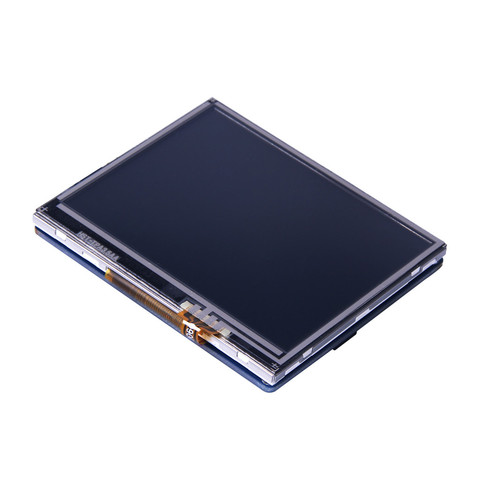DM-TFT35-107
Description
The DM-TFT35-107 display module, specifications and other resources are available from DisplayModule.com.
- 3.5"
- Resistive Touch Screen
- SD-card slot
- 4MB flash (32 Mbit)
- 262K color depth
- 240x320
- SPI interface
- 6 LED backlit
The display module has Arduino pinning.
Pinning
The following pins are used (not including GND and VCC):
| Arduino Pin | Function |
|---|---|
| D4 | ChipSelect for Touch |
| D6 | ChipSelect for Flash |
| D8 | ChipSelect for SD Card |
| D9 | Display Data/Command |
| D10 | ChipSelect for Display |
| D11 | SPI MOSI for Display, Touch, SD Card and Flash |
| D12 | SPI MISO for Display, Touch, SD Card and Flash |
| D13 | SPI SCLK for Display, Touch, SD Card and Flash |
Information
Note that the DIP-switch on the back of the display module must be in the UNO position for the SD Card to work. If the switch is in MEGA mode then the SD Card will fail.
Compatibility
The display module has been tested with the following platforms:
| Platform | Comment |
|---|---|
| LPCXpresso1549 | Add comment |
| EA LPC4088 QuickStart Board with a LPC4088 QSB Base Board | Add comment |
Software
There is a library to get you started with the displays:
Import libraryDmTftLibrary
Driver Library for our displays
To use the library:
main.cpp
#include "mbed.h"
#include "DmTftSsd2119.h"
#include "W25Q16BV.h"
#include "DmTouch.h"
/* Displays with adapter */
#define DM_PIN_SPI_MOSI D11
#define DM_PIN_SPI_MISO D12
#define DM_PIN_SPI_SCLK D13
#define DM_PIN_CS_TOUCH D4
#define DM_PIN_CS_TFT D10
#define DM_PIN_CS_SDCARD D8
#define DM_PIN_CS_FLASH D6
DmTftSsd2119 tft; /* DM_TFT35_107 */
DmTouch touch(DmTouch::DM_TFT35_107);
SDFileSystem sd(DM_PIN_SPI_MOSI, DM_PIN_SPI_MISO, DM_PIN_SPI_SCLK, DM_PIN_CS_SDCARD, "sd"); // mosi,miso,clk,cs
W25Q16BV flash(DM_PIN_SPI_MOSI, DM_PIN_SPI_MISO, DM_PIN_SPI_SCLK, DM_PIN_CS_FLASH); // mosi,miso,clk,cs
DigitalInOut csTouch(DM_PIN_CS_TOUCH, PIN_OUTPUT, PullUp, 1);
DigitalInOut csDisplay(DM_PIN_CS_TFT, PIN_OUTPUT, PullUp, 1);
DigitalInOut csSDCard(DM_PIN_CS_SDCARD, PIN_OUTPUT, PullUp, 1);
DigitalInOut csFlash(DM_PIN_CS_FLASH, PIN_OUTPUT, PullUp, 1);
int main() {
tft.init();
tft.drawString(20, 20, "x:");
tft.drawString(100, 20, "y:");
touch.init();
while(true) {
...
}
}
There are also some demo programs:
Import programdm_main
Shows how to use the display. Draws a bitmap from internal flash, some geometric shapes and some text
Import programdm_bubbles
Shows how to use the display. Draws circles that bounce around on the display.
Import programdm_calibrate
This application makes it possible to calibrate the touch screen. Note that the calibration data is not persistently saved. Either do the calibration on every startup or modify the default values in DmTouchCalibration.
Import programdm_touch
Shows how to use a display and the touch controller. Will display the X and Y coordinates of the current touch event.
Import programdm_sdcard
Shows how to use a display, the onboard SD Card and the onboard SPI Flash. Requires a display module with direct Arduino pinning
Import programdm_paint
Shows how to use a display and the touch controller. A very basic paint program.
Import programdm_calc
Shows how to use a display and the touch controller. A very basic calculator. Note that for some displays the LANDSCAPE define must be set for the layout to be correct.
1 comment on DM-TFT35-107:
Please log in to post comments.


The comments section says that when configuring for the LPC1549, information can be found on the issue with the USB TX/RX problem with the printf problem on the notebook section. I can't see anything here about that particular problem though?